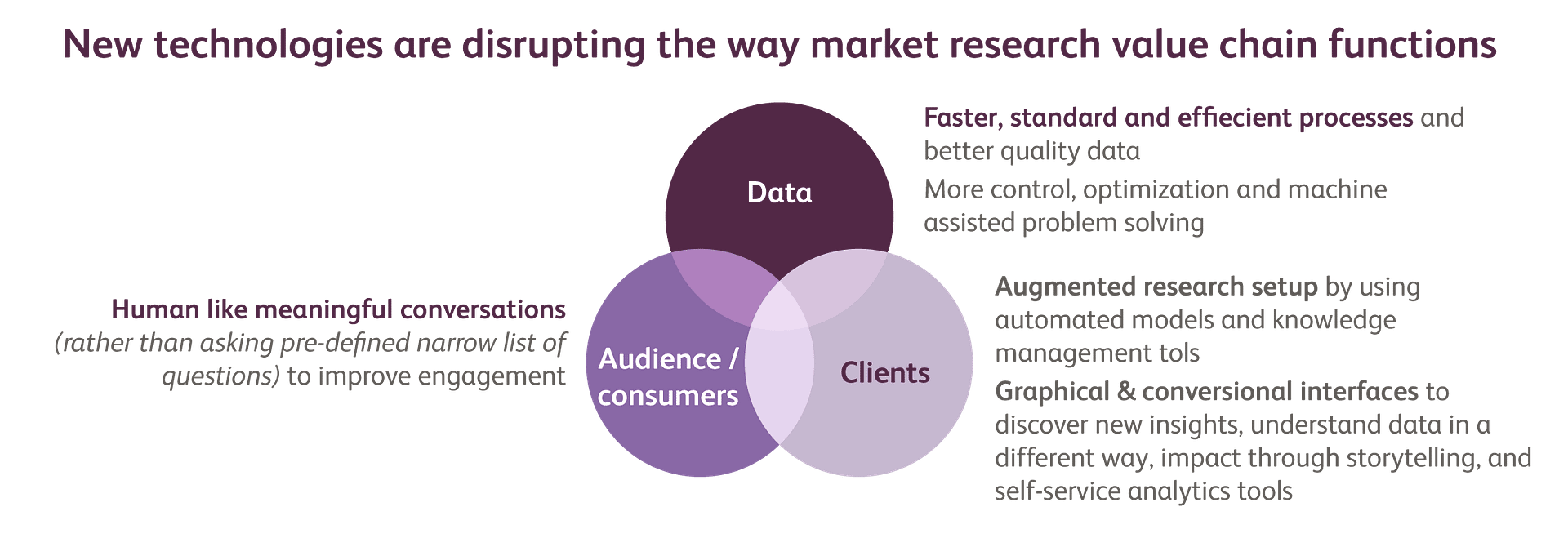The growth and change of market research (MR) is happening at an accelerated pace. This has enabled a multitude of organizations to address data-driven issues by using new technology to support their projects.
Recent advancements in digitization, data analytics and data management related technologies have started to impact the MR function in terms of its importance, insights, relevance, scope and nature of its operations, and eventual impact in corporate decision making. However, during this flurry of adoption and implementation, MR projects are being driven by data operations and data technology rather than by their most vital assets—clients.
The disadvantage of having a narrow technology focus is its inability to factor-in evolving business requirements. Achieving a faster and more efficient MR process through advanced technology is counter productive if the outcome is not aligned with business goals and vision. The inability to align technology with end-users and clients will make any productivity or efficiency gains seen as simple cost saving measures, rather than having a direct impact on the end-client. The heart of any MR function strives to make a positive impact on data, audience/consumers and clients.
- Audience: utilize the MR function to attain a deeper level of engagement with audiences. MR teams can now capture meaningful and relevant insights with open-ended questions, rather than using limited closed-ended questions. The advancement in technology (e.g. Natural Language Processing, Machine Learning, Artificial Intelligence) has made it easier for audiences to share their thoughts, which in-turn enables organizations to analyze the responses and efficiently derive insights. As a result, Organizations can make specific changes and plans which can align with their client’s goals.
- Data Operations: gain access to faster and cheaper data processing and reporting. Prior to the acceleration in the development of MR technology, these processes required significant amounts of manpower, time and capital. Value-additions such as data integration, advanced analytics and smarter systems are now in-scope for a range of organizations.
- End Users: there are greater collaborative possibilities between business functions. MR teams and businesses can collaborate with ease throughout the research process and generate relevant insights. End-users have access to reporting tools, contributing to the user experience by providing near-real time updates and actionable insights.
Harnessing emerging technologies that take an integrated approach towards targeting the entire MR value chain, while bringing relevant MR insights, allows business functions to reclaim ownership and command of their MR projects. Every new tool that is adopted by an organization will work to optimize the MR value chain, which will then contribute to generating actionable insights. An integrated approach also ensures that businesses can adapt and adjust throughout each step of the MR process. Having an agile and responsive process enables businesses to make sure they are achieving goals and objectives.

An integrated approach to MR helps clients achieve universal mapping and alignment of customer and business goals, ensuring that collaboration with stakeholders will achieve consistent results. Businesses will also be able to have a single view of customers through the integration of MR data with various other data sources (such as CRM, web, social, support data, etc.). Having near real-time insights will provide the client with a faster, scalable, responsive, efficient, accurate and effective insights engine.
- Firms are adopting technology in order to keep-up with evolving MR expectations, however these initiatives are focusing on making the data operations more efficient rather than making an impact on clients.
- Technology affects all parts of the MR function, which should work towards generating client-focused, relevant and actionable insights.
To learn more about how your MR function can be optimized and improved for your development needs, please write to marketing@evalueserve.com




